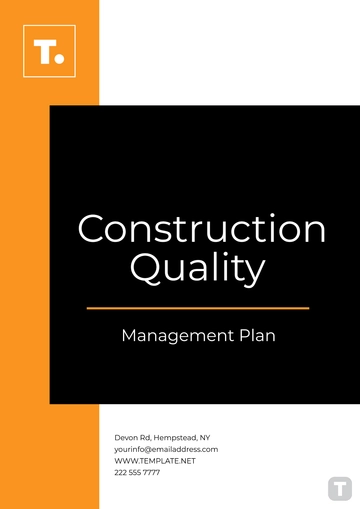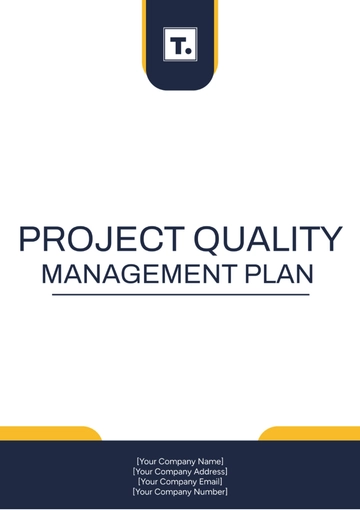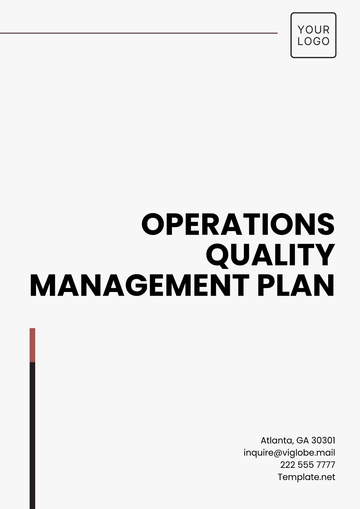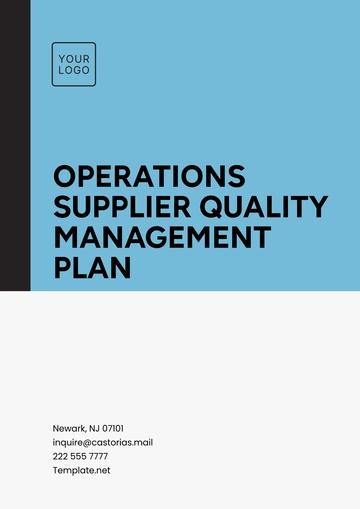Free Operations Quality Management Plan

Prepared By: | [Your Name] |
Company: | [Your Company Name] |
Date: | [Date] |
Introduction
This Operations Quality Management Plan is designed to ensure that [Your Company Name]'s operations meet industry standards, regulatory requirements, and customer expectations. It establishes a structured framework for maintaining quality in all aspects of operational processes, from production to delivery. By focusing on minimizing defects, enhancing efficiency, and exceeding customer satisfaction, this plan serves as a cornerstone for operational excellence.
1. Objectives
The key objectives of this plan are:
Compliance: Adhering to industry standards like ISO 9001, OSHA, or other relevant frameworks.
Error Reduction: Reducing defects in output to below 1% of total production.
Customer Satisfaction: Achieving a satisfaction score of 95% or higher through consistent service quality.
Efficiency Optimization: Enhancing operational efficiency by improving cycle times and resource utilization.
2. Quality Standards and Policies
2.1 Regulatory Compliance
Compliance with OSHA safety regulations for workplace operations.
Regular audits to ensure alignment with ISO 9001 standards.
Maintaining environmental sustainability practices in line with EPA guidelines.
2.2 Operational Metrics
Production Quality: Maintain defect rates below 0.8%.
Process Efficiency: Average production cycle time of 4 hours or less.
2.3 Customer Expectations
On-time delivery rate of 99%.
Post-service customer satisfaction surveys with an average score of 4.8/5.
3. Roles and Responsibilities
Quality Assurance Manager: Conduct audits, implement corrective actions, and oversee compliance with quality standards.
Operations Manager: Monitor workflow and ensure adherence to operational KPIs.
Employees: Follow established protocols and report any deviations or risks.
Senior Leadership: Approve policies, allocate resources, and provide strategic direction.
4. Quality Control Mechanisms
4.1 Monitoring Systems
Deploy real-time tracking systems, such as production line sensors and service delivery software.
Monthly quality audits to identify and address gaps in processes.
4.2 Corrective and Preventive Actions (CAPA)
Corrective: Address specific issues like equipment failures or missed delivery deadlines immediately.
Preventive: Regularly review SOPs and update them to mitigate recurring problems.
4.3 Key Performance Indicators (KPIs)
KPI | Target | Frequency |
|---|---|---|
Defect Rate | Below 0.8% | Weekly |
On-Time Delivery | 99% or higher | Monthly |
Customer Satisfaction | 95% or higher | Quarterly |
5. Continuous Improvement Strategies
5.1 Regular Process Reviews
Conduct quarterly reviews of inventory management and production workflows to identify inefficiencies.
Leverage customer feedback to refine service protocols.
5.2 Advanced Training Programs
Provide Six Sigma Green Belt training for managers.
Schedule mandatory refresher courses every six months for operational staff.
5.3 Technology Integration
Implement AI-powered analytics for predicting equipment maintenance needs.
Use IoT devices to monitor production quality in real time.
6. Risk Management
6.1 Risk Identification
Identify high-risk areas such as supply chain delays or equipment malfunctions.
Maintain a risk register updated with likelihood and impact scores for each identified risk.
6.2 Risk Mitigation
Develop contingency plans for supplier disruptions, including alternative sourcing arrangements.
Conduct quarterly drills to test emergency response procedures for operational hazards.
7. Implementation Plan
Task | Timeline | Responsible Party | Status |
|---|---|---|---|
Develop SOPs for production lines | 1 month | Quality Assurance Team | Pending |
Install real-time monitoring tools | 2 months | IT Department | In Progress |
Conduct employee training | 3 months | HR Department | Pending |
Pilot a new efficiency strategy | 4 months | Operations Manager | Pending |
8. Quality Reporting
8.1 Internal Reporting
Weekly defect rate reports are to be shared with all team leads.
Monthly operations review meetings to discuss quality metrics and corrective actions.
8.2 External Reporting
Submit quarterly compliance reports to regulatory bodies.
Publish annual operational quality reports for stakeholders.
9. Conclusion
This Operations Quality Management Plan provides a robust roadmap for ensuring operational quality. By adhering to defined standards, proactively managing risks, and fostering a culture of continuous improvement, it establishes a framework for meeting and exceeding customer expectations. The plan underscores a commitment to excellence, innovation, and long-term success in achieving operational goals.
- 100% Customizable, free editor
- Access 1 Million+ Templates, photo’s & graphics
- Download or share as a template
- Click and replace photos, graphics, text, backgrounds
- Resize, crop, AI write & more
- Access advanced editor
Optimize your quality assurance with the Operations Quality Management Plan Template from Template.net. This editable and customizable blueprint aids in establishing a comprehensive quality management system editable in our AI Editor tool. It's crafted to guide your team in maintaining and enhancing product and service quality, aligning with your operational objectives. Implement a robust quality management plan with this essential resource from Template.net.
You may also like
- Finance Plan
- Construction Plan
- Sales Plan
- Development Plan
- Career Plan
- Budget Plan
- HR Plan
- Education Plan
- Transition Plan
- Work Plan
- Training Plan
- Communication Plan
- Operation Plan
- Health And Safety Plan
- Strategy Plan
- Professional Development Plan
- Advertising Plan
- Risk Management Plan
- Restaurant Plan
- School Plan
- Nursing Home Patient Care Plan
- Nursing Care Plan
- Plan Event
- Startup Plan
- Social Media Plan
- Staffing Plan
- Annual Plan
- Content Plan
- Payment Plan
- Implementation Plan
- Hotel Plan
- Workout Plan
- Accounting Plan
- Campaign Plan
- Essay Plan
- 30 60 90 Day Plan
- Research Plan
- Recruitment Plan
- 90 Day Plan
- Quarterly Plan
- Emergency Plan
- 5 Year Plan
- Gym Plan
- Personal Plan
- IT and Software Plan
- Treatment Plan
- Real Estate Plan
- Law Firm Plan
- Healthcare Plan
- Improvement Plan
- Media Plan
- 5 Year Business Plan
- Learning Plan
- Marketing Campaign Plan
- Travel Agency Plan
- Cleaning Services Plan
- Interior Design Plan
- Performance Plan
- PR Plan
- Birth Plan
- Life Plan
- SEO Plan
- Disaster Recovery Plan
- Continuity Plan
- Launch Plan
- Legal Plan
- Behavior Plan
- Performance Improvement Plan
- Salon Plan
- Security Plan
- Security Management Plan
- Employee Development Plan
- Quality Plan
- Service Improvement Plan
- Growth Plan
- Incident Response Plan
- Basketball Plan
- Emergency Action Plan
- Product Launch Plan
- Spa Plan
- Employee Training Plan
- Data Analysis Plan
- Employee Action Plan
- Territory Plan
- Audit Plan
- Classroom Plan
- Activity Plan
- Parenting Plan
- Care Plan
- Project Execution Plan
- Exercise Plan
- Internship Plan
- Software Development Plan
- Continuous Improvement Plan
- Leave Plan
- 90 Day Sales Plan
- Advertising Agency Plan
- Employee Transition Plan
- Smart Action Plan
- Workplace Safety Plan
- Behavior Change Plan
- Contingency Plan
- Continuity of Operations Plan
- Health Plan
- Quality Control Plan
- Self Plan
- Sports Development Plan
- Change Management Plan
- Ecommerce Plan
- Personal Financial Plan
- Process Improvement Plan
- 30-60-90 Day Sales Plan
- Crisis Management Plan
- Engagement Plan
- Execution Plan
- Pandemic Plan
- Quality Assurance Plan
- Service Continuity Plan
- Agile Project Plan
- Fundraising Plan
- Job Transition Plan
- Asset Maintenance Plan
- Maintenance Plan
- Software Test Plan
- Staff Training and Development Plan
- 3 Year Plan
- Brand Activation Plan
- Release Plan
- Resource Plan
- Risk Mitigation Plan
- Teacher Plan
- 30 60 90 Day Plan for New Manager
- Food Safety Plan
- Food Truck Plan
- Hiring Plan
- Quality Management Plan
- Wellness Plan
- Behavior Intervention Plan
- Bonus Plan
- Investment Plan
- Maternity Leave Plan
- Pandemic Response Plan
- Succession Planning
- Coaching Plan
- Configuration Management Plan
- Remote Work Plan
- Self Care Plan
- Teaching Plan
- 100-Day Plan
- HACCP Plan
- Student Plan
- Sustainability Plan
- 30 60 90 Day Plan for Interview
- Access Plan
- Site Specific Safety Plan



